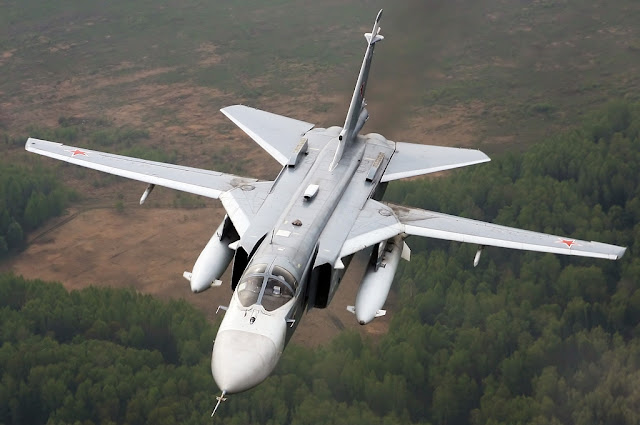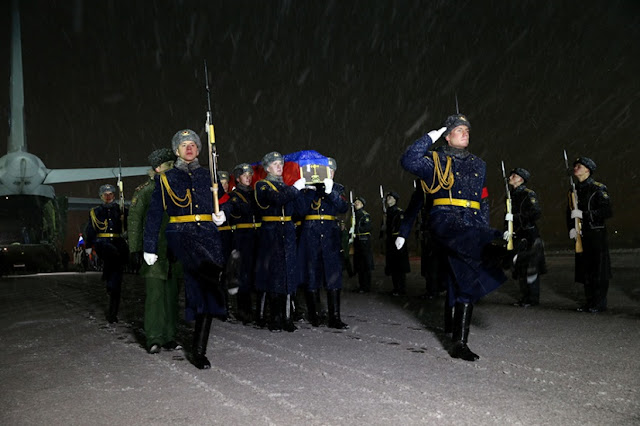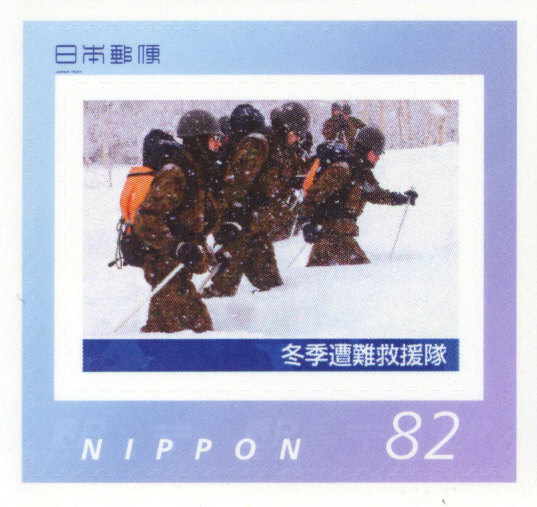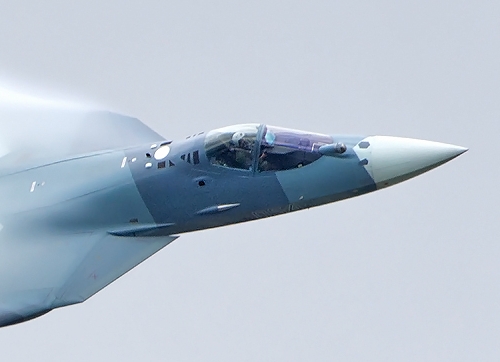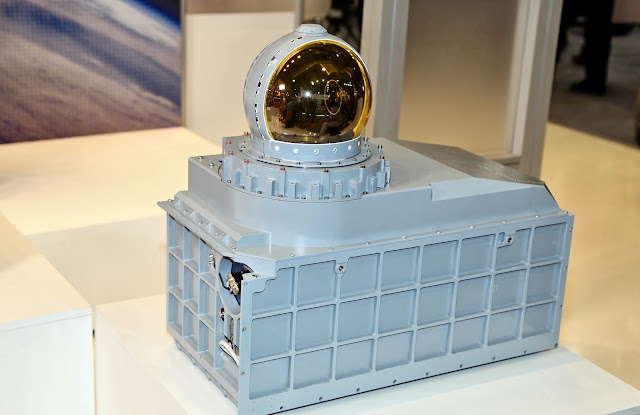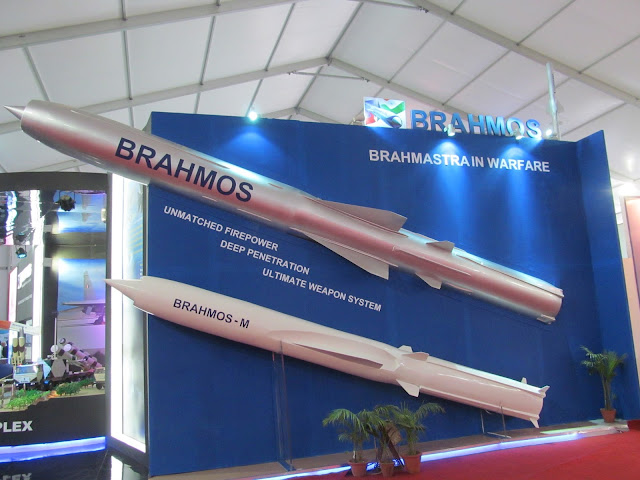Fencer Down ... Hip Down ...
No we are not referring to the Marianas Turkey Shoot of June 1944 or the Bekka Valley Turkey Shoot of June 1982. Ten days ago, a Russian Sukhoi Su-24M Fencer fighter-bomber on an bombing mission against Islamic State of Iraq and the Levant ( ISIL ) in northern Syria was shot down by F-16 fighters of the Turkish Air Force, after it apparently violated Turkish air space and did not respond to at least ten warnings over a period of five minutes. The aircraft was seen to have gone down in flames. Both crew ejected but one was killed by rebel fighters while the other was rescued.
Meanwhile a Mi-8 Hip helicopter dispatched to the crash site on a search and rescue mission made an unscheduled landing after it developed mechanical issues came under fire by Free Syrian Army rebel forces using supposedly American supplied TOW anti-tank missiles. It was also completely destroyed with one its crew member killed.
This has to be until now the worse day for the Russian Forces operating in Syria in support of the Assad regime. It was an accident waiting to happen, as multiple fast jets, helicopters and drones from various nations fighting ISIL ply the narrow and congested corridors in the boarder zones between Syria and Turkey with impunity. The situation was made more complicated by many previous violations of Turkish air space by Russian fighter jets in the past two months with Turkey warning about tough consequences and new rules of engagement.
According to the Washington Post, it was the first time in more than 63 years when an aircraft from a NATO member had shot down Soviet planes and it represented a serious international incident with the potential for escalation. Russian President Bloodimir Putin was naturally livid, claiming that the bomber was in Syrian air space within 1 km of the boarder when it was shot down, that it was a " stab in the back ".
Now, Russia has the perfect excuse to deploy advanced air defense missiles and more fighter jets to Syria, right at the doorsteps of NATO's southern boarder ... all thanks to the trigger-happiness of one madman Turkish President Recep Tayyip Erdogan.
The Syrian Morass
As the World knows, the popular Syrian uprising against their oppressive government lead by President Bashar al-Assad which began in the spring of 2011 quickly deteriorated into an all out civil war with multiple factions fighting the government forces as well as each other. Many of these factions are divided along ethnic or religious lines and are backed by various power players in the Middle-East like Turkey and Saudi Arabia while others have links to extremist organisations like al-Qaeda. The more moderate rebel militias received support from the US and the European Union. The Assad regime meanwhile received support from Russia, Iraq and even direct assistance from Iran in the form of Hezbollah fighters and military advisors on the ground. The situation became even more complicated by late 2012 when the Kurds in northern Syria, initially neutral, got dragged into the conflict as well.
It was unfortunate that all those events were happening at a time when the US forces was being drawn down in neighbouring Iraq. With the Iraq Army militarily weak and the command and government riddled with corruption, the Sunni insurgent group which called itself the Islamic State of Iraq ( ISI ) started to seize territory in northern and western Iraq, culminating in the capture of the City of Mosul. Lead by a core of former Ba'athist military and intelligence officers who served under the Saddam regime, ISI also established itself over the border in Syria as well, fighting both the Assad forces and the rebel forces simultaneously.
No doubt aided by the large quantities of weapons captured from the impotent Iraqi Army, many of which were donated by the US, the Islamic insurgents proved themselves to be a capable fighting force and rapidly gained territory in Syria. By April 2013, with large swathes of land straddling Iraq in the east and Syria in the west under its control, the organisation declared itself the Islamic State of Iraq and Syria ( ISIS ), sometimes also known as the Islamic State of Iraq and the Levant ( ISIL ), Islamic State ( IS ), or simply Daesh to the Arab speaking world.
ISIL has been labeled a terror organisation by the United Nations and many other countries around the world. It imposed strict Islamic law on the populace in the regions that it occupied and carried out hideous crimes against humanity including destruction of heritage sites, torture, rape, summary executions, beheadings and even ethnic cleansing. Internet savvy experts then upload videos of such criminal acts online as propaganda and to recruit fighters, many of whom were foreigners seeking adventure and glory. Funding came from various sources including the sale of oil and refined petroleum products, sale of looted antiques from state museums and institutions, tax imposed on the populace and businesses, ransom moneys paid by kidnapped victims ... you get the idea.
Coalition Air Campaign Against ISIL
While the United States was contented to initially providing non-lethal aid to the Syrian rebels at the beginning of the civil war, it soon became obvious that more had to be done for the rebels to at least have a remote chance of toppling Assad or warding off ISIL. Weapons, ammunition and training for moderate rebels soon followed. The gruesome beheading of several foreign journalists and aid workers by ISIL last year ultimately resulted in the commencement of air strikes in Syria on 22nd Sep 2014 by a coalition of nations which included the US, France, Canada, Australia, Turkey and several Arab League nations including Saudi Arabia, Qatar, Jordan, Morocco and the United Arab Emirates.
Obama and his Air Force brass were then quite confident of crushing ISIL within a matter of weeks with their bombing sorties but one year on they weren't so sure anymore. More and more aircraft types were quietly added to the strike fleet, including the A-10C Warthog and even the AH-64D Apache, but ISIL remained elusive and resilient. Let no one be deluded to believe that a few bombs dropped over a vast desert could actually defeat an insurgent group like ISIL without putting boots on the ground. Anyway, one after another, the various coalition partners lost their focus and withdrew their tiny fleets, leaving the US to shoulder the main burden of the air campaign. Jordan stopped contributing after its F-16 pilot was captured and burnt alive, Canada terminated its efforts after a change in government, the Arab League got distracted by a new conflict in Yemen.... . So that set the stage for the Russians to get their hands dirty too.
Russian Deployment To Syria
Russia had always kept close ties with Syria for as long as anyone could remember. Syria is its strategic partner in the Middle-East providing Russia with a naval base in the Mediterranean Sea. Syria is also an important client for Russian arms export, generating billions of dollars worth of hard cash for Putin. In return, Syria gets political support from Moscow at the international level, to shield it from any accusations of wrong doings or misdeeds. It is sort of a symbiotic relationship.
If the Assad regime goes, Moscow could lose its foothold in the Middle-East as the next government may not necessarily be Russia-leaning. So I suppose Putin finally decided that the time was ripe for direct Russian intervention in the Syrian civil war, one year after the US lead bombing campaign achieved hardly any results.
The most amazing thing about the Russian military deployment to Syria was no doubt the rapidness with which its was implemented when the order was given. The first indications of a possible Russian deployment came in September when a sudden increase in military air transport to the Syrian port city of Latakia was noted. Within days, the infrastructure to accommodate entire air wings were erected, complete with modular living quarters, control tower, helipads and the works. A ground protection force of marine commandos and T-90 main battle tanks and armoured personnel carriers were also deployed.
What followed was the deployment of close to 40 combat aircrafts of various types : 4 Su-30SM Flanker, 12 Su-24M Fencer, 4 Su-34 Fullback, 12 Su-25 Frog Foot and about a dozen helicopters including gunships.
 |
| Russian Air Force Su-25 Frog Foot ground attack aircraft at Hmeimim Air Base 2015. Photo Russian Defense Ministry. |
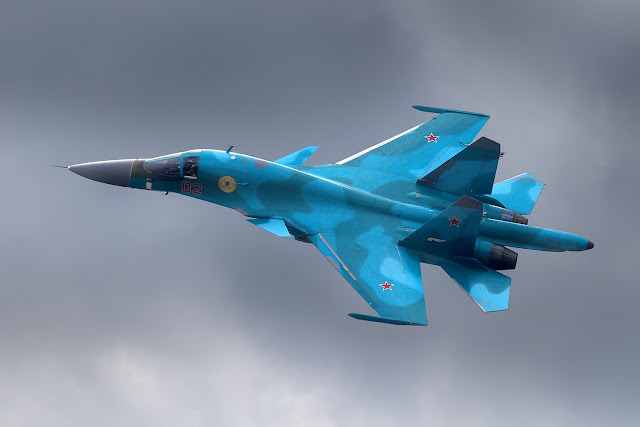 |
| Russian Air Force Su-34 Fullback fighter-bomber with its distinctive tandem seats, canards and stinger. Source : Wikipedia |
 |
| Su-30SM Multi-role Fighter with short range air-to-air missiles. Source United Aircraft Corporation |
The Su-24 is an ageing Soviet era supersonic fighter bomber with variable-sweep wings designed in the sixties, the equivalent of the General Dynamics FB-111 Aardvark of the USAF. The Su-25 is a dedicated ground attack aircraft very similar to the Fairchild Republic A-10 Warthog. The Su-30SM is an advance Flanker variant capable of both air-superiority and attack roles. The Su-34 is Russia's newest fighter-bomber meant to replace the Su-24 and Syria is the first operational deployment of this aircraft type. So, all in all, a small contingent which is mainly geared towards the attack role with only nominal fighter top cover, not surprising as the insurgents the Russians are fighting have no air assets of their own to threaten the Russian aircrafts.
Russian Anti-ISIL Air Campaign
All through October and much of November, the Russian aircrafts happily bombed what they insisted were ISIL targets. They authorities claimed that by 30th Nov, exactly 2 months since the commencement of the Russian air campaign, the air force had generated 2300 sorties and bombed 4100 terrorist targets, exceeding in just one month more that what the US and its allies did in a whole year. Of course to be fair the Russians operated from an airbase within Syria and transit time to the targets are very short while the American lead effort have to utilize air bases much further, like Incirlik in Turkey, or even in Europe.
Unfortunately, the Russians have been criticized for bombing the moderate anti-Assad rebels in western Syria rather than concentrating on ISIL strongholds in eastern Syria. They also attacked Turkey affiliated Turkmen rebels along the Syrian-Turkey boarder and that created friction with Ankara. To make matters worse, the Russians have not been exactly mindful of the Turkish airspace when conducting their bombing raids near the boarder. More than once, Russian bombers have strayed across the boundary into Turkish airspace. Despite many warnings that have been issued and rules of engagement ( ROE ) that have been revised, the Russians continued their careless patrols, seemingly oblivious to the Turkish threats to have violating aircraft shot down.
Recent Shoot Down Incidences
Since the beginning of the Syrian conflict, there has been numerous boarder incidences resulting in the shooting down of aircrafts belonging to both Turkey and Syria. On 22 Jun 2012, a Turkish RF-4E Phantom II reconnaissance jet was shot down by Syria after it unintentionally strayed into Syrian air space. The fighter crashed into the sea and both pilots died. This lead to Turkey revising its ROE stating that it would consider all "military elements" approaching from Syria an enemy threat and would act accordingly.
The next major incident occurred on 23 Mar 2014 when a Syrian MiG-23 Flogger strayed just a little into Turkey and promptly got hosed down, again by F-16 fighters.
 |
| A Russian MiG-23 Flogger armed with AA-7 and AA-8 air-to-air missiles. A similar Syrian aircraft was shot down by the Turks in 2014. Source RSK MiG. |
So, as one can observe, these boarder zones are extremely dangerous for aircrafts with both sides being highly on the edge just waiting for the other to commit a small mistake and have an excuse for taking down the opponent. Turkey especially, has been acting tough and had repeatedly made good their threats of shooting down violators of their sovereign air space.
Latest Shooting Down Incident
On 24 Nov 2015, a Russian Air Force Su-24M Fencer bomber operating out of Syria's Hmeimim Air Field was on a bombing mission near the Turkish boarder when according to Turkey, it strayed into Turkish air space to a depth of 2.19km, an incursion that lasted for a mere 17 seconds. It was fired upon by a F-16 fighter when it failed to respond to at least 10 repeated warnings within a 5 minute period to change course. These warnings were of course transmitted on radio over guard frequency. Guard is the aircraft emergency frequency reserved for communications when aircrafts are in distress or during an emergency. The frequencies are 121.5MHz for civilian aircrafts ( aka International air distress or VHF Guard ) and 243.0MHz for military aircrafts ( aka Military Air Distress or UHF Guard ).
Russia however, denied that the Fencer ever ventured into the said Turkish territory, a wedge-shaped piece of land jutting southwards into Syria measuring about 6km at its widest. It maintained that the bomber was returning to Hmeimim and flew within 1 kilometer of the Syrian boarder at all times when it was shot at an altitude of 6000m. Instead Russia counter-claimed that the Turkish F-16 actually made a 2km incursion into Syrian air space when it was attacking the Fencer.
 |
| Turkey Defense Ministry's map of Su-24's flight path. Source : Wikipaedia |
 |
| Russian Defense Ministry's map of the Su-24 flight path. Red line - Su-24, blue line - F-16. Source Wikipaedia |
 |
| Google Earth Map : the distance between the two red markers denoting the estimated entry and exit points of the Su-24 over Turkish sovereignty is ..... 2.20km! |
What probably happened was the Fencer was over Syrian soil AFTER its brief incursion into Turkey when it was struck by an air-to-air missile fired by the F-16. It would later emerge that the Fencer pilots claimed they did not receive any warnings over the radio and neither did they see the missile coming at them. In other words, they didn't know what hit them.
This could be possible as according to Wikipaedia, the Su-24M's antiquated R-862M VHF/UHF radio may not be able to monitor the military guard frequency without optional equipment which may not have been installed. As the Fencer is a fairly large aircraft with poor visibility from the cockpit, the pilots may not see an incoming missile especially when fired upon from the rear. Being an old aircraft it probably lacks a Missile Approach Warning System ( MAWS ) to guard against heat seeking missiles like the AIM-9X Sidewinder carried by the F-16. Radar Warning Receivers ( RWR ) may or may not provide timely warning against radio-frequency homing missiles as there may be latency between detection and threat identification.
After their plane was hit, both pilots bailed out but were fired upon by Turkmen rebels as they were descending in their parachutes. The flight commander Lieutenant Colonel Oleg Anatolyevich Peshkov was killed by ground fire while his navigator Captain Konstantin Murakhtin survived and was eventually rescued by Russian and Syrian SAR teams. Peshkov was posthumously awarded the title Hero of the Russian Federation while Murakhtin and the naval commando who perished in the helicopter attack during the rescue attempt was given the Order of Courage.
A Case of Intractable Trigger Happiness?
Could this unfortunate downing of the Fencer be avoided? Absolutely! When accidents happen, they usually have multiple factors contributing to the final outcome. In this case both Russia and Turkey could have done more to prevent just such an event.
Firstly, Russia should not have sent its bombers so close to a volatile boarder. Patrolling 1 km from the boundary as claimed is stupid. Ever heard of stand-off ordnance? Even if you have to target insurgents near or at the boarder, it could be done at stand-off distances and Russia has no shortage of stand-off weapons, and was even willing to use cruise missiles fired from the Caspian Sea 1500km away even though it had absolute air-superiority over Syrian skies.
Secondly, in the event the need to fly near the boarder becomes necessary, at least ensure the aircrafts are equipped with the appropriate communications and navigation equipment and the flight crew properly trained to use them. A military aircraft unable to monitoring Military Guard frequency is just unbelievable, what ever the reason. And the upgraded Su-24M are supposed to be GLONASS equipped.
Nobody in the free world believes what Russia says anymore, especially after their denial about direct intervention in Crimea and eastern Ukraine despite glaring evidences indicating otherwise, like the capture of Russian paratroopers deep inside Ukrainian territory. So the Russian claim about the Su-24 never venturing beyond 1km of the Syrian boarder is probably false. In any case, would Turkey dare to shoot down a Russian combat aircraft flying over Syrian territory without provocation? Rather unlikely, I would say, even though the Turkish Air Force is quite powerful, being the world's third largest operator of the F-16 fighter ( with close to 300 mainly advance block 50 version ) after the US and Israel, it is still no match for the might of the Russian Air Force. So I would take the Turkish data as closer to the truth and it indicated that the Fencer violated Turkish air space for a total of 17 seconds and for a flight distance of just 2.19km.
To shoot down an aircraft after such a brief incursion which in all likelihood could be unintentional, some kind of navigational error or a momentary lapse of concentration on the pilot or navigator's part, can only be labeled as extreme trigger happiness if not murder.
Frankly, there are other less lethal ways to resolve this type of boarder incidences including intercepting and escorting the offending aircraft back to where it should belong. Flying along side and making visual contact when radio communications could not be established might be necessary. If all else failed, firing a short burst of cannon rounds across the bow usually would get the attention of the offending aircraft. Ripping it out of the sky should be the last resort.
Turkish President Erdogan had refused to apologise to Russia after the shooting incident, insisting that Turkey reserves the right of self-defense in the event of violations of territory, which in principle is true. Putin on the other hand, believed that the unprovoked shooting is a stab in the back by a supposed ally in the fight against terror. He was so incensed that he accused Turkey of profiting from the illegal trading of oil with ISIL, even claiming direct involvement of Erdogan's family members, and therefore had a reason to protect ISIL oil infrastructure. The spat has now escalated even further as Putin continues to trade verbal blows with Erdogan piling on one insult after another.
 |
| Back Stabbing! Satirical illustration from the Sputnik News Agency's Japanese website depicting Erdogan sneaking up on the Bear. The Japanese words read TERORISUTO ( terrorist ). |
The Aftermath
As a consequence of the downing of the Fencer, Russia has immediately taken steps to strengthen its air defense capabilities in Syria.
First, the missile cruiser Moskva ( ex-Slava ), flagship of the Russian Navy Black Sea Fleet, an 11490 ton monster of a warship armed with a total of 64 ( 8 x 8 rotary launchers ) SA-N-6 Grumble long-range surface-to-air missiles was dispatched to the waters off the Syrian coast to provide an air defense umbrella for the Russian strike aircrafts. The SA-N-6, also known as the S-300F Fort, is the navalised version of the S-300P ( NATO reporting name SA-10 Grumble ) land based anti-aircraft missile. It has a maximum effective range of 95 miles, enough to cover large portions of northern Syria and southern Turkey.
 |
| The Moskva, flagship of the Black Sea Fleet with 8 x 8 SA-N-6 Grumble long-range SAM in a 2009 photo. Wikipaedia |
Within three days of the downing of the Fencer, Moscow also deployed its most advanced air defense system to Hmeimem Air Base - the S-400 Triumf ( NATO reporting name SA-21 Growler ) surface-to-air missile. Depending on the missile type used, the maximum range for the S-400 system is up to 400km. Although Russia says that the S-400 systems deployed in Syria are not for sale and would be returned to Russia once their mission is over, we know that Russian words count for nothing. I am quite sure the S-400 will stay put in Syria for a very long time, as its is extremely easy to claim that the mission is not yet over, or just simply provoke another incident or shoot down your own aircraft and blame it on enemy fire or whatever, its been done before.
 |
| Two S-400 Triumf transporter-erector-launcher units ( Left and Centre ) protected by what looks like a Pantsir S1 air defense system ( Right ) at Hmeimem Air Base in Syria. Source : Sputnik |
Also, for the first time since their deployment in Syria, the Su-34 Fullbacks are conducting their bombing raid carrying ground attack ordnance and air-to-air missiles for self-defense. Russia is making it clear to Turkey that any future downing incidences would be met with immediate and lethal respond. The Fullbacks are basically upsized Flankers with a tremendous increase in range and carrying capacity and although optimized for bombings can be used for air combat as well. Below is a video clip from RT showing the Su-34 with the medium-range R-27 ( AA-10 Alamo ) on centre pylon and the short-range R-73 ( AA-11 Archer ) air-to-air missile on outer pylon, in addition to OFAB-500 dumb bombs on the undercarriage and KAB-500 TV-guided aerial bombs ( with glass covered tip ) at the innermost pylon. These spanking new bombers on their first ever combat deployment deserve a separate coverage / article on their own!
In the near future, Russia will likely increase the number of Su-30SM fighters deployed in Syria to ultimately provide fighter escort to all of its bombing sorties especially those conducted near the Turkish boarder or establish some kind of combat air patrol.
Russia also started economic sanctions against Turkey, with Prime Minister Dmitry Medvedev signing a decree prohibiting the importation of food from Turkey and banning chartered flights between the two countries. The ban would apply to produce like fruits and vegetables, poultry and salt and will commence on 1st Jan 2016. Russian citizens have also been advice to refrain from travelling to Turkey unless absolutely necessary by their foreign ministry.
Meanwhile, the skies over Syria becomes ever more crowded and dangerous, with the Royal Air Force now commencing air strikes against ISIL targets within Syrian territory ....
 |
| Russian Air Force Su-24M in a 2009 photo. Wikipaedia |
 |
| Russian Air Force Su-24M at Latakia, Syria, 2015. Wikipaedia |
 |
| Su-24M taking off at Hmeimim Air Base. Source Russian Defense Ministry |
